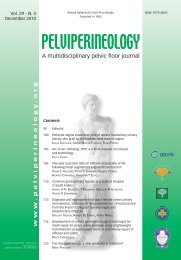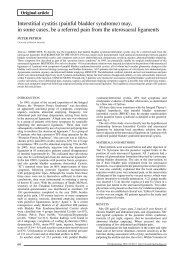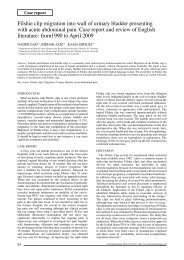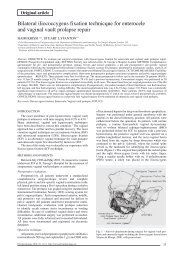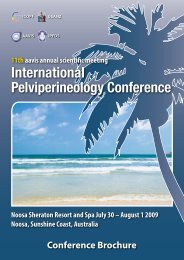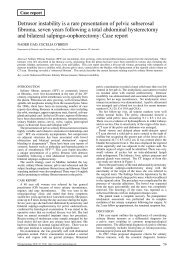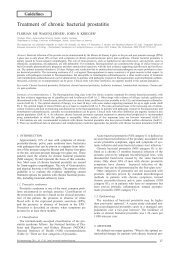This Issue Complete PDF - Pelviperineology
This Issue Complete PDF - Pelviperineology
This Issue Complete PDF - Pelviperineology
You also want an ePaper? Increase the reach of your titles
YUMPU automatically turns print PDFs into web optimized ePapers that Google loves.
Original article<br />
Posterior intravaginal slingplasty: Feasibility and preliminary<br />
results in a prospective observational study of 108 cases<br />
PETER VON THEOBALD - EMMANUEL LABBÉ<br />
Department of Gynecology and Obstetrics, University Hospital of Caen, France<br />
Abstract: The Posterior Intravaginal Slingplasty has been evaluated in a continuous prospective series of 108 patients with an average follow<br />
up time of 19 months. Peri-operative and post-operative complications were recorded as well as an anatomical and functional assessment. The<br />
morbidity of the Posterior IVS procedure appears comparable if not lower than that of spinofixation in terms of dyspareunia and buttock pain.<br />
The technical feasibility is excellent. Insertion of the Posterior IVS tape is far easier to achieve than with the spinofixation technique, and it<br />
is quicker to perform than sacrocolpopexy. Follow-up of our patients at long term will reveal whether Posterior IVS will also offer the same<br />
advantages of durability or long term cure as shown by abdominal prosthetic repairs.<br />
Key words: Genital prolapse; Mesh repair; Polypropylene; Posterior Intravaginal Sling.<br />
INTRODUCTION<br />
Adequate treatment of genital prolapse requires a defect<br />
specific approach. Repair of upper compartment prolapse<br />
(vaginal vault, hysterocoele, enterocoele) can involve<br />
abdominal or laparoscopic techniques such as sacrocolpopexy<br />
1-10 the Kapandji type operation, 11, 12 combined<br />
abdominal/vaginal techniques 7, 12, 13 or techniques using the<br />
vaginal route, such as spinofixation 14-17 or MacCall type culdoplasty.<br />
18 Peter Petros 19 described a new technique using<br />
a sling of polypropylene mesh for suspension of upper compartment<br />
organs which have prolapsed, called “Posterior<br />
Intra Vaginal Slingplasty” (PIVS), and for which a more<br />
detailed name would be “infracoccygeal translevatorial colpopexy”.<br />
The main aim of this study is the assessment of the feasibility,<br />
the morbidity and the anatomical results obtained<br />
with the Posterior Intra Vaginal Slingplasty (PIVS) technique<br />
for the treatment of severe uterine or vaginal vault<br />
prolapse by reporting the outcomes of a continuous series of<br />
108 cases with an average follow-up of 19 months. The secondary<br />
aim is to use the same criteria to assess the treatment<br />
of any associated cystocoele and rectocoele by interposition<br />
of a prosthesis (Surgipro* Mesh - Tyco Healthcare, USA).<br />
MATERIALS AND METHODS<br />
A series of 108 consecutive patients, with a mean age<br />
of 60 years (range 36 and 82), who presented with genital<br />
prolapse giving rise to symptoms, were included between<br />
August 2001 and July 2003. To be eligible for inclusion,<br />
the prolapse had to include descent of upper compartment<br />
organs (vaginal vault, hysterocoele or enterocoele) with a<br />
point C > 0 cm according to the POP-Q classification. 20<br />
Cystocoele and /or rectocoele, if associated, were given specific<br />
treatment.<br />
In every patient, the clinical examination during consultation<br />
was re-assessed under anaesthesia. The first assessment<br />
served to include the patients, and the second was the basis<br />
for the final decision of treatment. All patients underwent<br />
PIVS; and in addition, those with an associated cystocoele<br />
or a rectocoele were treated with placement of a polypropylene<br />
mesh in the vesico-vaginal or recto-vaginal space<br />
respectfully. Hysterectomy was not performed to treat prolapse.<br />
Rather, hysterectomy was only performed for medical<br />
indications such as meno- or metrorrhagia with a polymyomatous<br />
uterus, symptomatic uterine hyperplasia or cervical<br />
dystrophy. In a case of isolated hypertrophic lengthening<br />
of the cervix, trachelectomy was carried out. When stress<br />
urinary incontinence was diagnosed at clinical examination<br />
12<br />
with full bladder or when the closing pressure was less<br />
than 25 cm water, a sub-urethral tape was inserted using<br />
the Anterior Intravaginal slingpplasty (IVS) technique via a<br />
separate vaginal incision beneath the mid urethra.<br />
<strong>This</strong> is a prospective, observational study. All patients<br />
were seen 6 weeks post operation, again after 6 months, and<br />
then every year by the surgeon or another gynaecologist in<br />
the department.<br />
The main study criteria were patient morbidity (peri-operatively<br />
and immediately post-operatively, as well as long<br />
term morbidity), and also the anatomical and functional<br />
results at short term with respect to the PIVS.<br />
The secondary study criteria were patient morbidity (perioperatively,<br />
immediately post-operatively as well as long<br />
term), together with the anatomical and functional results at<br />
short term with respect to the insertion of vesico-vaginal and<br />
recto-vaginal interposition prostheses.<br />
In order to improve the morbidity study, three sub-groups<br />
were created: the first group included all patients who had<br />
had a hysterectomy (Group 1), the second group were the<br />
patients who had undergone a PIVS with or without a rectovaginal<br />
prosthesis and/or a sub-urethral sling (Group 2) and<br />
the third group consisted of patients who underwent treatment<br />
for cystocoele by means of a vesico-vaginal interposition<br />
prosthesis (Group 3). (PIVS for vault prolapse also)<br />
The Krikal-Wallis test was used for statistical analysis of the<br />
duration of hospital stay and Pearson’s chi-square test (exact<br />
p-value with SPSS Exact Tests module) for loss of haemoglobin.<br />
Surgical technique<br />
When vaginal hysterectomy is required, it is performed<br />
initially in the standard fashion. Treatment of cystocoele (if<br />
any) follows next with a sagittal anterior colpotomy. If a<br />
retropubic sub-urethral sling needs to be inserted for treatment<br />
of urinary stress incontinence, the colpotomy incision<br />
stops 4 centimetres from the urethral meatus and the tape is<br />
inserted via a separate incision. Vesico-vaginal and vesicouterine<br />
dissection should be wide enough to reach the pelvic<br />
fascia laterally. Perforation is required each side of the bladder<br />
neck, opening a tunnel towards the Cave of Retzius.<br />
The multifilament polypropylene material ( Surgipro ®<br />
Mesh TYCO Healthcare, USA) used for the vesico-vaginal<br />
anterior interposition prosthesis measures 4 centimetres in<br />
width, and 6 to 8 centimetres in length, and has two anterior<br />
tapered extensions or strips. It is cut from a 15 by 8 centimetre<br />
portion of mesh from which the posterior prosthesis<br />
can also be cut in order to be economical. It should cover the<br />
entire width of the bladder and reach the base of the vagina.<br />
The two anterior strips of the prosthesis are slipped through<br />
<strong>Pelviperineology</strong> 2008; 27: 12-16 http://www.pelviperineology.org



